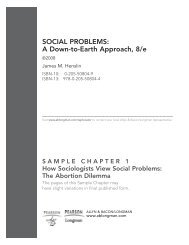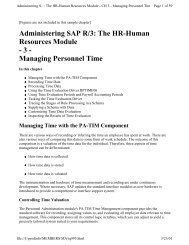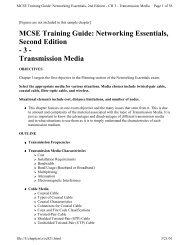CULTURE, language, AND COGNITION
CULTURE, language, AND COGNITION
CULTURE, language, AND COGNITION
You also want an ePaper? Increase the reach of your titles
YUMPU automatically turns print PDFs into web optimized ePapers that Google loves.
GA305c05.qxd 4/30/2004 11:26 AM Page 110<br />
110 culture, Language, and cognition<br />
Indians to learn English as their second <strong>language</strong>. “Official” <strong>language</strong>s other<br />
than the native <strong>language</strong>s can also be found in Zaire (French) and Nigeria<br />
(English). Educational settings, on the other hand, are those in which formal<br />
second-<strong>language</strong> instruction takes place. The traditional “foreign <strong>language</strong><br />
classroom,” a common high school or college experience for many readers,<br />
comes immediately to mind. In addition, other educational settings might include<br />
bilingual education programs (for immigrant students in the United<br />
States) or education of ethnic minority children (in mainstream classrooms)<br />
as is common in Britain, Germany, and the Unites States.<br />
A widespread assumption is that a second <strong>language</strong> is learned differently<br />
in different settings but that the patterns are somewhat unclear. We do<br />
know that it is not always the natural setting that leads to successful mastery<br />
of a second-<strong>language</strong>. In fact, it is more likely that educational settings provide<br />
better opportunities to learn a second <strong>language</strong>, but only if they involve<br />
immersion in both the native and the second <strong>language</strong>. (e.g., bilingual programs).<br />
Speaking in “ecological terms,” being immersed in a second <strong>language</strong><br />
means <strong>language</strong> is used within multiple levels of the ecological model (e.g.,<br />
school, work place, sports club, grocery store, media).<br />
Related to these settings are important social and psychological factors.<br />
For example, there is general agreement among researchers that attitudes<br />
towards the target <strong>language</strong> and culture as well as motivation to learn the<br />
<strong>language</strong> have an enormous influence on second-<strong>language</strong> learning. In an illustrative<br />
study, Scully (2000) collected data from Filipinas (who married<br />
into Japanese households) about their attitudes towards Japanese culture<br />
and their success in learning Japanese. The author found that immersion in<br />
the culture and family life, as well as positive attitudes towards Japanese culture,<br />
predicted successful mastery of Japanese. See Table 5.1 for a depiction<br />
of the relationship of attitudes, motivation, and potential <strong>language</strong> learning<br />
outcome.<br />
A possible answer to the question posed earlier in this section could be<br />
as follows: individuals who wish to learn a second <strong>language</strong> at an older age<br />
may indeed develop near-native proficiency if they can choose a favorable<br />
ecological system and have a positive attitude!<br />
� Childhood<br />
As we move from the infancy and early childhood periods to the school-age<br />
period, the majority of cross-cultural Piagetian studies have focused on the<br />
transition from the preoperational period to the concrete operational period<br />
and the attainment of conservation (Gardiner, 1994). These studies show<br />
great variability in their findings (Rogoff, 1990). Fishbein (1984) points out<br />
that the research literature on these topics, published during the 1960s and<br />
early 1970s, reports consistently large differences (as much as seven years) in<br />
the favor of children in Westernized cultures when compared with children
















